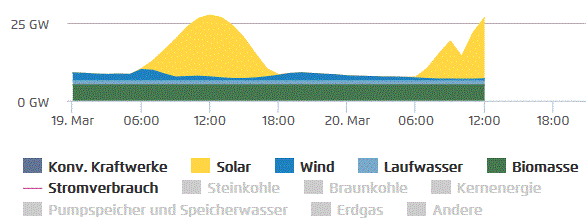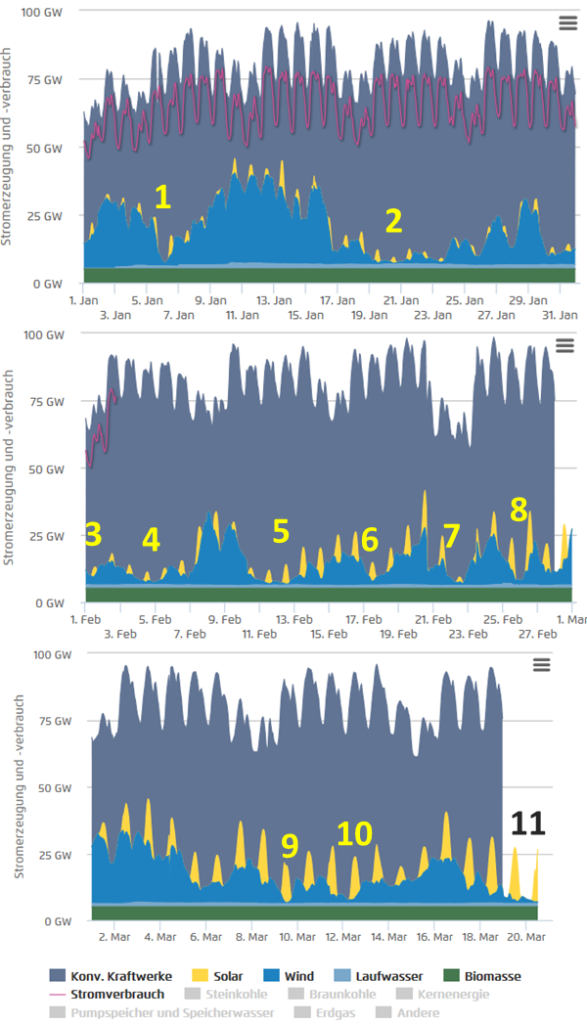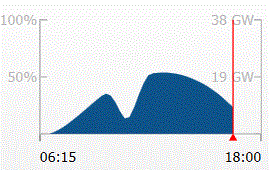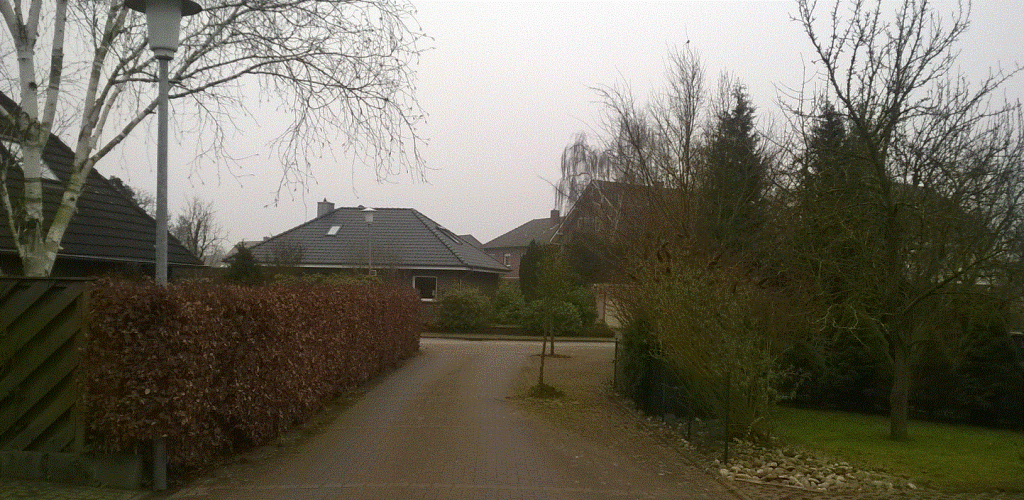It’s a good thing Germany still has a lot of conventional power supply from coal and nuclear on line. Otherwise the entire country would have blacked out this morning during the partial eclipse of the sun. Conventional fuel saved the day.
As the following diagram depicts, there was almost no wind output from Germany’s 40 or so gigawatts of installed wind capacity over the last 36 hours. The country’s wind turbines called it an early weekend.
Wind energy (blue) has virtually disappeared over the last 36 hours. Solar disappears every night, and often during the day in the wintertime. Often less than 1% of Germany’s electrical demand gets supplied by wind and sun. Source: agora.
German wind and solar power disappeared this morning and over the last 36 hours, leaving fossil and nuclear power to step in to the rescue. The following chart of Germany’s energy supply and demand shows how wind has gone AWOL already 11 times since January 1:
Since January 1, Wind power failed to show up some 11 times. On average about 85% of the installed capacity doesn’t show up to begin with. Charts cropped from agora.
The point here is that it doesn’t matter how much wind and solar capacity gets installed. Once the wind stops blowing and the sun does’t shine, which is often enough, you get no power – period. Imagine if a doctor sold you an artificial heart that could run for 100 years, yet the heart pumped only sporadically, sometimes at only a beat or two a minute over for hours or even days. So it is with wind and solar energy. Our society needs a steady and constant supply; it can’t afford to constatntly stall and sputter, otherwise it collapses and dies.
Today’s partial eclipse had little impact
Today’s partial eclipse of the sun did not strain Germany’s power grid as much as feared. Fog and cloudy weather over northern Germany helped to dampen the feared fluctuation. Sunny day projections of 12,000 megawatts of power going offline in just an hour followed by 19,000 megawatts surging online in an hour warned that the grid could be destabilized. Here’s what the sunny-day scenario solar feed-in looked like:
Sunny day solar power feed in into grid during eclipse. Source: cropped form here. Animation by: pvspeicher.htw-berlin.de.
What actually happened was nowhere near as bad as feared:
Fluctuation was far less than feared. Source: SMA.
As the sun’s energy disappeared, conventional fuels saved the day.
What follows is a photo I took outside near peak time of the partial eclipse in northwest Germany, where it was overcast:
10:45 this morning. Looks like a typical dreary day in north Germany.
In general, power companies and grid operators had months to prepare for the eclipse. Lapses and wild fluctuations in wind and sun energy are common (see above) and so today’s eclipse was manageable though with considerable effort. Power companies asked large consumers such as aluminum smelters, cement plants and glass manufacturers to ramp down their production before the event. That would not have been necessary with conventional power.










The Solar max output is quite impressive, but do you know what it averages out at over the 24 hours?
It would really be better if it wnet in to storage to smooth it out.
“It would really be better if it wnet in to storage to smooth it out.”
I am really sorry, but this is false. PV Solar is providing electricity during daytime, when demand is much stronger than at night. At some places on earth, PV Solar is in extremely good correlation with peak demand times, then the situation is even better.
In general, electricity sells for about half the price at night, so by “smoothing” it out over 24 hours you would lose about a quatre of the revenue that you could have had without the smooth.
At a medium timerange, solar will be forced to “smooth” a little, because PV solar will ruin the price of electricity during peak solar times (what was once peak price time will turn into a bargain). But this smooth will mostly happen by different placing (towards evening sun) and not by storage.
Storing PV solar power to provide electricity at night is a huge waste, until you get to a rather extreme level of solar penetration.
There is a wonderful datasource for this, from the Fraunhofer Institute.
You will like this, as it is nearly only data and next to no interpretation at all.
http://www.ise.fraunhofer.de/en/downloads-englisch/pdf-files-englisch/data-nivc-/electricity-spot-prices-and-production-data-in-germany-2014.pdf
You get graphs about demand and supply and the spotmarket price (one day in advance, but even better, daily trading prices.
Check page 17 for a serious negative price event on the 20th of april 2014. By clicking on the button you can directly jump to page 82, where the problemn is explained. (in this case, load projection and solar/wiond output were both about 4 GW to low/high).
Take a look at the data and you will see: Sloar is in good correlation with high electricity trading prices. Extreme price events often happen because of false demand estiamtes as well!
“At some places on earth, PV Solar is in extremely good correlation with peak demand times” ???
Not in Australia. The morning peak starts when it is dark and the wind turbine output drops off.
Peak solar output is for 5 hours from approx. 10 a.m. so the high evening demand isn’t supplied by solar. (summer sunset here is around 8.30 p.m.)
Science of Doom who was shown up spreading misinformation and even lies used the name SOD. Is SOD20 the same person? What he says is untrue. Solar energy has been shown to be unreliable and unviable (without government subsidies) in areas of high solar input such as in Spain and inland Australia. In Australia peak demand occurs from 6 AM to 10AM during weekdays. That is the time when factories, offices and retail establishments start. Solar can never supply base load because a) it can only supply while the sun shines and this averages around 6 hrs per day over the year (remember it rains and there are clouds) b) requires 100% standby energy generation -this is at least makes it 4 to 5 times the capital cost and at least 100% of the operating cost of a base load electricity generation c) the solar supply is intermittent, the supply can be reduced rapidly by over 50% if clouds roll in. Very rarely can they guarantee to an electricity market operator the next 30 minutes of supply. (smae applies for wind generation)
ScienceOfDoom was a lawyer AFAIK and intelligent enough to run MODTRAN. Also, he had English as first language and probably knew the meaning of “sod” – so he always called himself “scienceofdoom”.
Sorry, but your calculations are false. Building a reserve structure would cost exactly the same as building the normal fossil structure. Then you can add in solar (more expensive) and wind (most liekly cheaper than fossil fuel) and you would typically end up at double the cost.
If you want an even more extreme scenario, you could assumne double the price of conventional power for alternative sources. Then you will end up with three times the price. A higher factor does not make any sense.
And you also have to factor in, that you would get a much better power source (new conventional AND additional wind/solar power).
—————————
The times are changing. Costa Rica has run on 100% renewables over the first 75 days of this year.
http://www.sciencealert.com/costa-rica-powered-with-100-renewable-energy-for-75-days
(yes, the majorrity of thsi is hydro)
Sweden ( and i admit again, also much hydro) has reached over 50% of TOTAL power consumption from renewables (they are changing their transport sector as well, so this no longer is just electricity part!)
http://www.zeit.de/wirtschaft/2015-03/energiewende-verbrauch-deutschland-europa-vergleich
Again you (SOD) are providing misinformation. An OECD/IEA report of which the executive summary is here https://www.oecd-nea.org/pub/egc/docs/exec-summary-ENG.pdf (the full report is also available) states
1/ The cheapest power in the world is nuclear in Asia (particularly South Korea) at $US29-40/MWhr, followed by coal in Asia-Pacific (Australia, China etc), then Nuclear in Europe (France, Finland etc)
2/ For solar photovoltaic plants load factors vary from 10% to 25%
3/ At the high load factor the levelised cost of solar-generated electricity (does not include standby generation) are reaching $US 215-333/MWhr (ie 4 to 6 times the cost of coal fired electricity)
If you had any experience in the engineering subject of heat transfer then you would know that AGW is a scam. However, regardless of that the future in electricity generation is from Nuclear. Coal and gas use are intermediate technologies.
“1/ The cheapest power in the world is nuclear in Asia (particularly South Korea) at $US29-40/MWhr”
Sorry again. Your report is from 2010. There was a huge nuclear disaster in Fukushima after this report (which has the Nuclear Energy Agency logo on its front..).
And in Korea there was a massive scandal about cheap material used in building nuclear power plants.
http://en.wikipedia.org/wiki/South_Korean_nuclear_scandal
A realistic current price of nuclear in the western world is provided by the Hinkley plant project at about 138$ per MWh.
http://en.wikipedia.org/wiki/Hinkley_Point_C_nuclear_power_station
But let us look at the new data from the US (2014, scroll down to the table, about 2 pages):
http://www.eia.gov/forecasts/aeo/electricity_generation.cfm
Coal at 95$, wind at 80$. and solar PV at 130$. That is pretty much what i described above.
And let us not forget, this is the US, with cheap coal and even cheaper natural gas (and not a single running offshore wind plant..).
Do you have a new OECD source? i am really curious, how their numbers changed since 2010, as so much happened!
“Sweden, a wet, mountainous land gets by with hydro and… NUCLEAR. ”
Sweden has been adding a TWh of wind each year since 2000 and is planning for 30Mwh in 2020 (that would be about 50% of current nuclear power).
http://en.wikipedia.org/wiki/Electricity_sector_in_Sweden
The countries with huge hydro capacities have a double advanatge on a way to high level renewables: They have a headstart AND hydro combines very well with wind/solar (pump storage).
sod:
I suppose it is too much to expect you to stop deluding yourself but you might at least try to be accurate in your comments.
e.g. A realistic current price of nuclear in the western world is provided by the Hinkley plant project – One analyst at Liberium Capital,[33] described the strike price as ‘economically insane’ …expect EDF to earn a Return on Equity (ROE) well in excess of 20%..
That’s what happens when politicians get involved in something they don’t understand, like electricity supply, the money boys gouge the public purse. See also Germany.
Coal at 95$, wind at 80$. and solar PV at 130$. That is pretty much what i described above. –
Firstly these are predictions not facts, and coal is penalised with extra costs e.g. operating back up generators at a loss, plus carbon capture.
Secondly you have been claiming solar PV is cheaper than fossil fuel.
And, as I have said before, just because you think something should happen you believe it will.
Sweden also plans to command the wind to blow constantly 24/7.
Shamans are in hot demand.
“One analyst at Liberium Capital,[33] described the strike price as ‘economically insane’ ”
The Hinkley price is insane. If you can make a cheaper offer or if you know a company that can, why not bring it forward?
The “price” of a thing, is the amount of money that you get when you sell it (sort of a “market value”). The Hinkley price is the best estimate of the price of new nuclear in the western world. you can not just dismiss it!
—-
“Secondly you have been claiming solar PV is cheaper than fossil fuel.”
no, i did not. i wrote: “…solar (more expensive)…”
Solar PV is cheaper than coal power, if you use your own roof top solar and the comparison is to the prcie at which electricity is being sold. That is a different aspect, which is irrelevant to this argument.
———-
“And, as I have said before, just because you think something should happen you believe it will.”
sorry, but i was replying to an article “PROJECTED costs of electricity (2010)”.
https://www.iea.org/publications/freepublications/publication/projected_costs.pdf
I just pointed out, that the information is outdated and that newer data shows a completely different picture (both were “projections”. my source in the US is not a “green” one…).
—————————
meanwhile Denmark is building offshore wind at about 10 euro cent per kWh.
http://www.maritime-executive.com/article/worlds-cheapest-offshore-wind-farm-underway
As offshore wind has a much higher capacity factor (close to 50%?) than onshore wind, i expect that you will prefer those. Actuially many other power sources have similar capacity factors in real use (hydro or gas, for example).
This page is a must read on capacity factor for wind:
http://energynumbers.info/capacity-factor-of-wind
And through a summoning of the elder gods, the Danes will make wild-eyed optimistic price prognoses by lobbyists turn into the literal truth. And live happily ever after.
Also, magically, the offshore thing will not corrode. (helped by a few thousand tons of cadmium sacrificial anodes)
I always love it when pro-“unreliable renewables (UR)” (aka pro carbon) fall back on examples where the few RELIABLE renewables do a good job at supporting demand.
Costa Rica (a very small country astride rainy volcanic mountains) can make a lot of hydro AND geothermal. Whoopi!
Sweden, a wet, mountainous land gets by with hydro and… NUCLEAR.
Maybe the pro UR should learn from Sweden rather than Germany. Get what you can from RELIABLE renewables and get the rest from NUCLEAR! (By the way, that is what Ontario is working toward.)
please excuse me, my last answer to you did end up in the wrong place above.
Take a look at these graphs (and ignore the source for a moment, just look at the stats!):
http://cleantechnica.com/2015/03/18/studies-flag-wind-huge-slice-global-power-2050/
The direct comparison between wind and nuclear shows wind being ahead nearly everywhere.
And the reason is simple: wind is cheaper and it can be deployed much faster.
And again, in Texas, definitely not a greenish place, wind power is delivering cheaper electricity than other sources.
http://www.dallasnews.com/business/energy/20150305-once-extravagant-renewable-power-plans-go-cheap.ece
sod;
your post 23. March 2015 at 20:50
The Hinkley price is insane. Of course it is, because politicians haven’t a clue and waste money. Something they are also doing with wind.
From your link (slightly rearranged for clarity)
The park will provide cheaper power than recently established wind farms at home and abroad. However, the agreed price with Vattenfall is more than three times higher than wholesale Nordic power price of 2.8 euro cents per kWh for delivery in 2017.
Danish power consumers will have to cover the difference between the market price and the price agreed with Vattenfall by paying subsidies,
Vattenfall’s bid at an agreed price of 10.31 euro cents per kilowatt-hour came below the price of 14.07 euro cents/kWh (15.15 euro cents/kWh in fixed 2015 prices) charged by Dong’s Anholt Offshore Wind Farm which means that Danish consumers could save about 295 million euros over the next 11-12 years. That means Danish taxpayers will be paying €5.9 million EXTRA for the joys of wind energy. WHY?
Also you don’t seem to understand reality when you say “Solar PV is cheaper than coal power, if you use your own roof top solar” – The price of power from the grid is increased by the costs of solar and wind, which include running inefficient plants to supply backup.
By the way, what does sod stand for? Stupid and obstinate are obvious but what could ‘d’ mean something in german?
Don’t expect a reply, you are an example of the failure of education leaving students unable to think and only capable of sprouting slogans.
” However, the agreed price with Vattenfall is more than three times higher than wholesale Nordic power price of 2.8 euro cents per kWh for delivery in 2017.”
This is a comaprison between old and new power sources. How would new coal fare under such circumstances?
” The price of power from the grid is increased by the costs of solar and wind, which include running inefficient plants to supply backup. ”
That is a claim that i heard multiple times, but it is plain out false.
A typical example is Hawaii, were powe was produced by petroleum and where we get cheaper power now, by adding alternatives.
http://en.wikipedia.org/wiki/Energy_in_Hawaii
up to a level of about 20-30% you will need no additional backup and solar and wind will also have a t worst a marginal effect on the price of fossil power producers (it actually will drive the price down, by having an effect on merit order sales).
But i am ready to learn. do you have a link on the effect on fossil fuel? a link with empirical data?
Germany has the equivalent of 800 full sun hours a year. At 7600 hours a year total, that’s about an average 10% capacity factor. During noon in August it reaches 100%, momentarily.
7600 hours a year?
Is all of Germany on Kurzarbeit? 🙂
There are 8760 hours in a normal year. So 800 “full sun” hours per year is closer to 9%. On average. Of course it’s much lower in Winter.
Yeah well that happens when I give numbers from memory.
What a relief! I can’t tell you how concerned I was that Europe’s grid might not be able to survive a cloudy, err, eclipse day.
(Of course, I was not at all concerned, which is why I can’t tell you how concerned I was….)
Oh – I hear it’s going to get dark again tonight! Is that going to be a problem?
Had the wind been strongly fluctuating, the story might have been different.
Perhaps the wind generator were paid to stay quiet for the morning. The worst-case power fluctuation from the eclipse wasn’t plausibly disasterous in itself as wind power picks up and drops off at a similar rate. Combined however, the perturbance may have been too rapid and large.
In germany the eclipse was less than 80%. I was surprised at how large the fall in electricity was.
As a gesture of good will, I suggest we loan them some prominent politicians and Al Gore to help them with their wind deficit.
Perhaps, with an option to keep?